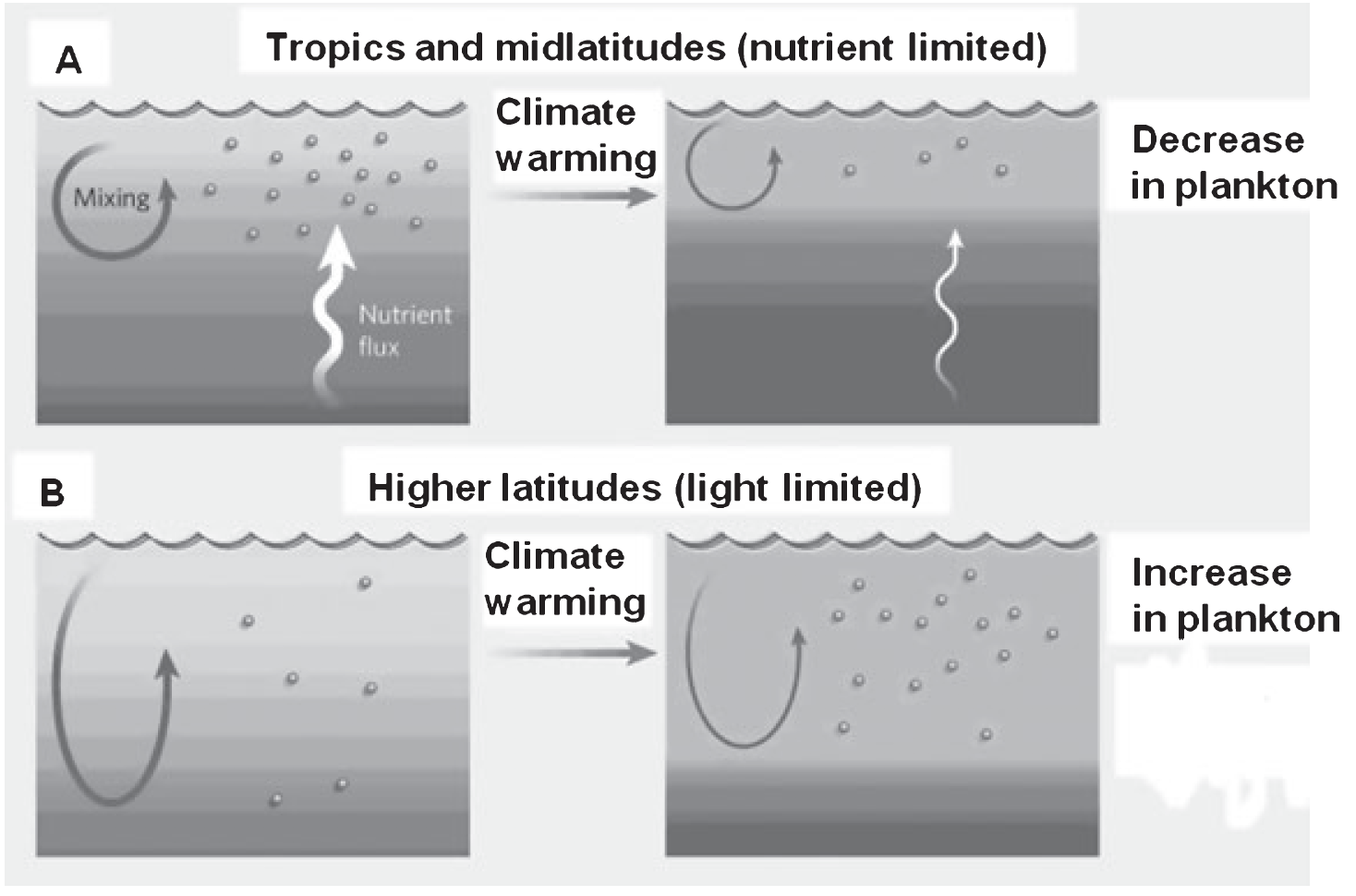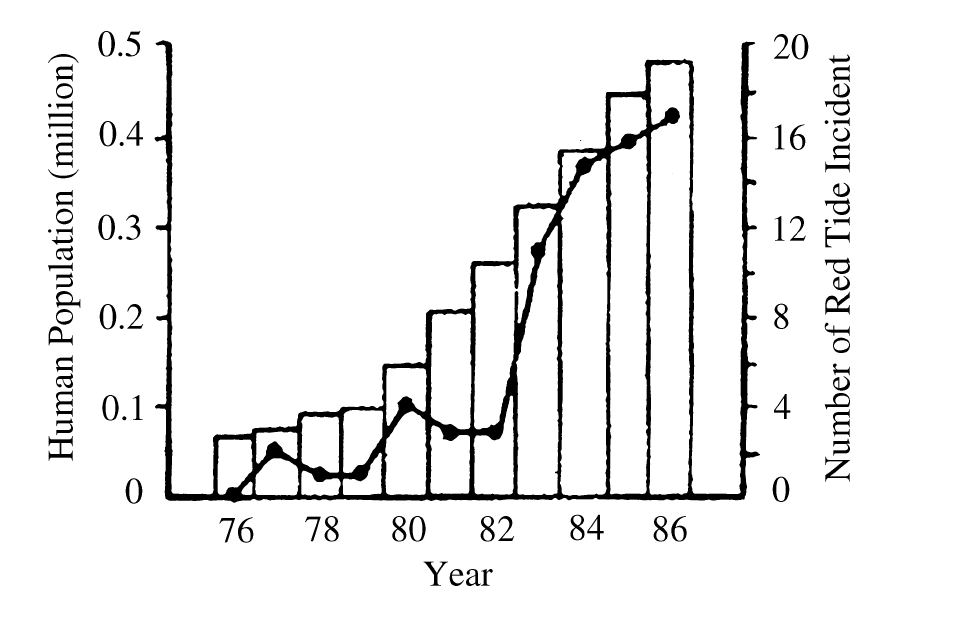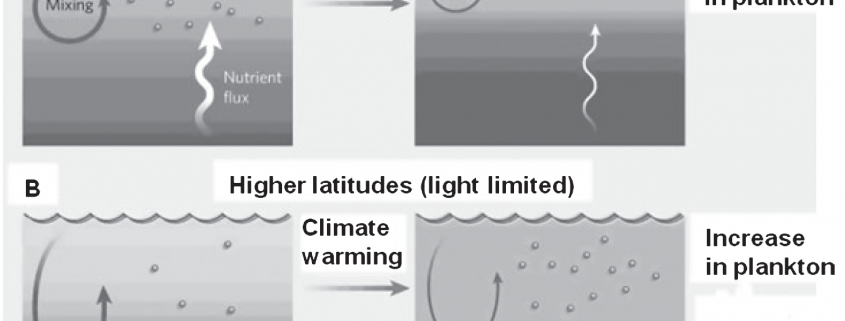A microscopic organism with a macroscopic impact: How climate change is affecting harmful algal blooms and what this means for future generations
By Carolyn Hamman, SRC intern
Phytoplankton are photosynthetic microorganisms that exist in both marine and freshwater environments. There are several different types of phytoplankton each with their own unique preferred environmental parameters and strategies for growth. For example, some phytoplankton (called coccolithophores) use calcium to create protective plates they use as a defense mechanism (Beaufort et al. 2011). Phytoplankton are a vital component in aquatic ecosystems as they are responsible for the majority of primary productivity that occurs. In fact, phytoplankton have been considered a driver in climate as 30% of anthropogenic carbon emissions have been absorbed by the ocean and over 90% of the heat increase the Earth has seen the ocean has taken up (Hallegraeff 2010). While phytoplankton plays a vital role in many processes in the ocean, there are also occurrences of harmful algal blooms (HABs). HABs are phenomena that have been a natural process throughout history (Hallegraeff 2010). These blooms can be harmful for two reasons. Certain species of phytoplankton can produce different types of neurotoxins that have been known to cause different problems such as respiratory issues (such as with the Florida Red Tides) or gastrointestinal and neurological illnesses. HABs don’t have to necessarily produce toxins to be considered harmful. The dense covering that algal blooms can cause blocks UV light from reaching certain depths of the ocean. The high amount of phytoplankton will cause a depletion in nutrients that can disrupt other ecosystems who rely on the nutrients as well. Once the phytoplankton finally use up the nutrients, they die in massive amounts that deplete the oxygen in the water and causes massive anoxia (Hallegraeff 2010).
Climate refers to the large-scale changes that occur in the atmosphere, hydrosphere, and cryosphere (Hallegraeff 2010). There are natural fluctuations in the climate that have caused periods of warming or cooling. However, since around the Industrial Revolution, the CO2 levels have increased from 280 to >380 ppm, and there have been temperature increases in the past 40 years that are at a rate far faster than ever seen before (Hallegraeff 2010). Phytoplankton have short generation times and longevity, which means they can respond quickly to climate change. This is true for HABs as well. Though phytoplankton species can evolve and change, the changing environmental parameters will favor species with certain parameters. As climate continues to change, it is imperative to understand how HAB will respond. The issue is that there are numerous amounts of factors that all play a role in determining which species of algae bloom (Zingone & Enevoldsen 2000). These stressors caused by climate change can include increased temperature, enhanced surface stratification, alteration of ocean currents, intensification or weakening of nutrient upwelling, stimulation of photosynthesis by elevated CO2, reduced calcification from ocean acidification, and changes in land runoff and micronutrients (Hallegraeff 2010). Each of these parameters can be analyzed to determine how HAB will respond to climate change. In the past 30 years, there has been an increase in frequency and intensity of HAB as well as how widespread they are (Hallegraeff 2010).
As greenhouse gas concentrations have increased there has been an increase in surface temperature, lower pH, and changes in vertical mixing, upwelling, precipitation, and evaporation patterns (Moore et. al. 2008). As current strength and number of blooms have increased, the range of HAB has expanded (Hallegraeff 2010). Areas that had previously not seen HAB have noticed a significant increase in the past decade. HAB rely on temperature to bloom, and with an increase in overall temperature blooms have started to occur earlier than what has previously been observed (Hallegraeff 2010). Phytoplankton living in shallower areas will also be more effected by temperature than phytoplankton in open oceans (Hallegraeff 2010). This means that HAB closer to the shore will undergo larger changes than the populations in the open ocean. With increased greenhouse gases comes increase in sea-level, wind, and mixed-layer depth, which has an impact on the number of upwelling and downwelling events and thus concentrations of macronutrients (Hallegraeff 2010). The change in wind will also influence transport of nutrients by air (known as aeolian transport). The net result is a decrease in mixing depth at higher latitudes, which results in higher phytoplankton biomass (Hallegraeff 2010). A noticeable change in precipitation is occurring due to climate change as well, where there are now periods of concentrated rainfall followed by long dry spells. This change is causing certain dinoflagellates (a type of phytoplankton) to bloom in higher concentrations than previously seen before (Hallegraeff 2010).

A schematic showing how climate warming affects mixing in low and high latitudes. The differences in mixing results in differences in HAB (Hallegraeff 2010)
The environmental changes caused from climate change has caused HAB patterns not previously seen before. Going in to the future, the species-specific responses to these parameters can be used to better predict where HAB will occur and the concentration they could occur at. The potential issue with such predictions is that it is exceedingly difficult to be able to predict how several environmental parameters working together will cause phytoplankton to respond. It is recommended that there be a more improved global ocean observation system that can monitor all of these parameters simultaneously (Hallegraeff 2010). As previously mentioned, there could be increased adverse effects on human health due to increased HAB, but very little has been done to study how humans respond to different phytoplankton toxins (Moore et. al. 2008). More research is needed to evaluate associations between human health and HAB to better respond when harmful algal bloom occurrence continues to increase in to the future.

A graph showing the relationship between the number of algal blooms and human population over time. Populations and boom frequency have both increased over time (Zingone & Enevoldsen 2000)
Works cited
Beaufort, L., Probert, I., De Garidel-Thoron, T., Bendif, E. M., Ruiz-Pino, D., Metzl, N., … & Rost, B. (2011). Sensitivity of coccolithophores to carbonate chemistry and ocean acidification. Nature, 476(7358), 80.
Hallegraeff, G. M. (2010). Ocean Climate Change, Phytoplankton Community Responses, And Harmful Algal Blooms: A Formidable Predictive Challenge. Journal of Phycology, 46(2), 220-235. doi:10.1111/j.1529-8817.2010.00815.x
Moore, S. K., Trainer, V. L., Mantua, N. J., Parker, M. S., Laws, E. A., Backer, L. C., & Fleming, L. E. (2008). Impacts of climate variability and future climate change on harmful algal blooms and human health. Environmental Health, 7(S4), 1-12. doi:10.1186/1476-069x-7-s2-s4
Zingone, A., & Enevoldsen, H. O. (2000). The diversity of harmful algal blooms: A challenge for science and management. Ocean & Coastal Management, 43(8-9), 725-748. doi:10.1016/s0964-5691(00)00056-9



